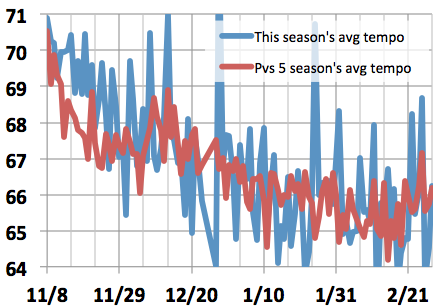Among the things officials had to deal with this season were new interpretations (“hey defenders, stop touching ball-handlers”) and real changes to rules. There were 29 changes to the rules this season. A lot of them had to do with expanding the jurisdiction of replay or cracking down on certain uniform issues. My personal favorite was this one…
Dead ball. (Rule 6-6.3). A try in flight shall not become dead when a shooter’s teammate excessively swings his elbows without making contact.
If you’ve been at a game where that has ever come up, well, I’d call you a liar. I cannot imagine a scenario, except maybe a game of NBA JAM, where that has come up.
But by far, the most important rules change was this one…
Establishing Legal Guarding Position – (Rule 4-17.4.d). When the opponent with the ball is airborne, the guard shall have attained legal guarding position before the opponent begins his upward motion with his hand/arms to shoot or pass.
When the data started arriving early in the season, it was obvious the new rules interpretations/changes were having an impact on the game. Fouls were up, free throws increased, points per possession rose, as did the number of possessions in a typical game. That wasn’t all: two-point accuracy finished with the highest mark since 2007. Three-point percentage was the highest since ‘08.
You know about free throws, but the increase in free throw percentage had little to do with the new rules. That’s the thing – shooters are better than they ever have been, and now that they’ve been given room to shoot, they’re making defenses pay.
So even if you think the crackdown on contact was excessive, it did have some benefits. Unfortunately, the increase in tempo we saw earlier in the season completely vanished by the end of the season, as shown here.

That trend has continued into March and April. Actually, recent games have become even slower than at the same time last season. Last year, the 67 NCAA tournament games produced an average of 65.0 possessions per 40 minutes, and that was in a record-slow season. This season, the tournament has produced an average of 63.5 possessions per 40 minutes.
That should concern you about whether the recent changes in the rule book are going to have a lasting impact. True, some of the decrease is probably due to the particular dynamics of this tournament, what with slow-paced teams advancing far. But even the other three post-season tournaments showed a decrease from last season, dropping from 67.2 to 66.4 possessions per 40 minutes.
Theoretically, players should have adjusted by now, and fouls in tournament are actually fairly close to their 2013 levels. It appears players have adjusted, but not in the way I would have expected. Apparently, in a low-turnover environment, offenses feel more comfortable than ever in working the shot clock as a result.
The good news—to the extent that good is associated with higher scoring, which for me, it is—is that efficiency remains high. Points per possession were probably higher than ever, and thankfully that trend has persisted during the tournament. This season’s tourney games have produced 1.067 points per possession compared to 1.011 last season. Do the math and you’ll find that bulk scoring in the tournament is up about 3% from last season, or just under two points per 40 minutes. That’s off from the 4.6% bump during the entire season, but it’s better than nothing.
There’s a lot more to consider than just efficiency and pace as to whether the rules changes were effective, and I’m sure the NCAA has been tracking more sophisticated things as part of its evaluation. But really it boils down to whether the game is more exciting now than it was over the past two to three seasons. Barring a standardization to the NBA shot clock, a high-efficiency/slow-paced game (with lots of monitor reviews!) is probably the future of college hoops. Whether that’s a more compelling game than the one of 20 years ago, when there were eight more possessions for each team per game, is up to America to determine.

